wersja polska (Polish version)
back to Liebmann main page
Liebmann - galleries.
DEMO_XY - gallery
Gallery of problems (2D electrostatic fields (X-Y)), which can be solved by DEMO_XY demonstrator.
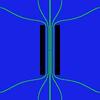 Two parallel plates in vacuum (mesh 200 x 200).
Two parallel plates in vacuum (mesh 200 x 200).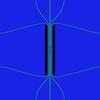 Two parallel plates in vacuum (mesh 400 x 400).
Two parallel plates in vacuum (mesh 400 x 400). Plane diode with lateral plates at the cathode potential (mesh 201 x 201).
Plane diode with lateral plates at the cathode potential (mesh 201 x 201). "S" - shaped formed electrode inside grounded casing (mesh 500 x 300).
"S" - shaped formed electrode inside grounded casing (mesh 500 x 300). Electrolytic tank with 2 electrodes in grounded casing (mesh 601 x 401).
Electrolytic tank with 2 electrodes in grounded casing (mesh 601 x 401).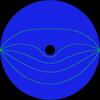 Dual-anode magnetron "with smile" (mesh 401 x 401).
Dual-anode magnetron "with smile" (mesh 401 x 401).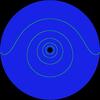 Dual-anode magnetron (such as in Paszkowski's book, page 62 or page 51 in English edition) (mesh 401 x 401).
Dual-anode magnetron (such as in Paszkowski's book, page 62 or page 51 in English edition) (mesh 401 x 401). Slit diaphragm (such as in Paszkowski's book) (mesh 401 x 401).
Slit diaphragm (such as in Paszkowski's book) (mesh 401 x 401). Two parallel plates in vacuum - inequal length (mesh 200 x 200).
Two parallel plates in vacuum - inequal length (mesh 200 x 200). Slit diaphragm - "weird version" (mesh 401 x 401).
Slit diaphragm - "weird version" (mesh 401 x 401). Electrolytic tank with 2 electrodes (inequal diameters of electrodes) (mesh 601 x 401).
Electrolytic tank with 2 electrodes (inequal diameters of electrodes) (mesh 601 x 401). Electrolytic tank with 2 electrodes (inequal diameters of electrodes, but the same potential) (mesh 601 x 401).
Electrolytic tank with 2 electrodes (inequal diameters of electrodes, but the same potential) (mesh 601 x 401). Two parallel plates in vacuum (inequal length) (mesh 400 x 400).
Two parallel plates in vacuum (inequal length) (mesh 400 x 400). Electrostatic quadrupole (mesh 401 x 401).
Electrostatic quadrupole (mesh 401 x 401). Cylindrical capacitor (mesh 401 x 401).
Cylindrical capacitor (mesh 401 x 401). Electrostatic quadrupole, defined in radial coordinates (mesh 401 x 401).
Electrostatic quadrupole, defined in radial coordinates (mesh 401 x 401). Electrostatic hexapole, defined in radial coordinates (mesh 401 x 401).
Electrostatic hexapole, defined in radial coordinates (mesh 401 x 401). Electrostatic "asymmetrical" quadrupole, defined in radial coordinates (mesh 401 x 401).
Electrostatic "asymmetrical" quadrupole, defined in radial coordinates (mesh 401 x 401).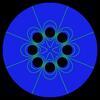 Electrostatic octupole, defined in radial coordinates (mesh 401 x 401).
Electrostatic octupole, defined in radial coordinates (mesh 401 x 401). Electrostatic quadrupole with "plate - shaped electrodes" (mesh 401 x 401).
Electrostatic quadrupole with "plate - shaped electrodes" (mesh 401 x 401). Problem 21 - from Physics Stack Exchange, (JohnDow's question) (mesh 170 x 125).
Problem 21 - from Physics Stack Exchange, (JohnDow's question) (mesh 170 x 125). Problem 22 - from Physics Stack Exchange, (JohnDow's question) (mesh 210 x 170).
Problem 22 - from Physics Stack Exchange, (JohnDow's question) (mesh 210 x 170). Problem from Physics Stack Exchange, (JohnDow's question) (mesh 190 x 280).
Problem from Physics Stack Exchange, (JohnDow's question) (mesh 190 x 280). Problem from Physics Stack Exchange, (JohnDow's question) (mesh 401 x 401).
Problem from Physics Stack Exchange, (JohnDow's question) (mesh 401 x 401). Problem from Physics Stack Exchange, version "with ellipse" (JohnDow's question) (mesh 401 x 401).
Problem from Physics Stack Exchange, version "with ellipse" (JohnDow's question) (mesh 401 x 401). Problem from Physics Stack Exchange, version "in casing" (JohnDow's question) (mesh 401 x 401).
Problem from Physics Stack Exchange, version "in casing" (JohnDow's question) (mesh 401 x 401). Plate and cylinder - version 1 (mesh 401 x 401).
Plate and cylinder - version 1 (mesh 401 x 401). Plate and cylinder - version 2 (closer) (mesh 401 x 401).
Plate and cylinder - version 2 (closer) (mesh 401 x 401). Plate and cylinder in grounded casing - version 1 (plate and cylinder have the same potential) (mesh 401 x 401).
Plate and cylinder in grounded casing - version 1 (plate and cylinder have the same potential) (mesh 401 x 401). Plate and cylinder in grounded casing - version 2 (plate and cylinder have different potentials) (mesh 401 x 401).
Plate and cylinder in grounded casing - version 2 (plate and cylinder have different potentials) (mesh 401 x 401). 2 plates in grounded casing (version v1) (mesh 401 x 401).
2 plates in grounded casing (version v1) (mesh 401 x 401). 2 plates in grounded casing (version v2) (mesh 401 x 401).
2 plates in grounded casing (version v2) (mesh 401 x 401). Cylinder in grounded casing (mesh 401 x 401).
Cylinder in grounded casing (mesh 401 x 401). 3 cylinders in grounded casing (mesh 401 x 401).
3 cylinders in grounded casing (mesh 401 x 401). Smooth 'S' shaped electrode (mesh 401 x 401).
Smooth 'S' shaped electrode (mesh 401 x 401). Plane triode (version A) (mesh 401 x 401).
Plane triode (version A) (mesh 401 x 401). Plane triode (version B) (mesh 401 x 401).
Plane triode (version B) (mesh 401 x 401). Faraday's cup (version A) (mesh 161 x 181).
Faraday's cup (version A) (mesh 161 x 181). Faraday's cup (version B) (mesh 161 x 181).
Faraday's cup (version B) (mesh 161 x 181). Faraday's cup (version C) (mesh 161 x 181).
Faraday's cup (version C) (mesh 161 x 181). Faraday's cup (version D) (mesh 161 x 181).
Faraday's cup (version D) (mesh 161 x 181). Faraday's cup (version E) (mesh 161 x 181).
Faraday's cup (version E) (mesh 161 x 181). Faraday's cup (version F) (mesh 401 x 401).
Faraday's cup (version F) (mesh 401 x 401). Faraday's cup (version G) (mesh 401 x 401).
Faraday's cup (version G) (mesh 401 x 401). Faraday's cup (version H) (mesh 401 x 401).
Faraday's cup (version H) (mesh 401 x 401). Faraday's cup (version I) (mesh 401 x 401).
Faraday's cup (version I) (mesh 401 x 401). Pseudo - dipole (version A) (mesh 401 x 401).
Pseudo - dipole (version A) (mesh 401 x 401). Pseudo - dipole (version B) (mesh 401 x 401).
Pseudo - dipole (version B) (mesh 401 x 401). Pseudo - dipole (version C) (mesh 401 x 401).
Pseudo - dipole (version C) (mesh 401 x 401). Pseudo - dipole (version D) (mesh 401 x 401).
Pseudo - dipole (version D) (mesh 401 x 401).
Comparison of computation time (DEMO_XY) for two environments: Laptop and Desktop.
Desktop
CPU - Intel(R) Core(TM) i5-9500F 3.0 GHz (4.4 GHz max turbo frequency)
MS Windows 10 Pro
32GB RAM
SSD disk
MSYS2, ucrt
gcc 14.2.0
Laptop (rather old, A.D. 2012)
Lenovo G580
CPU - Intel(R) Core(TM) i3-2370M 2.40 GHz
Linux Mint 21.1 Vera
Linux version 5.15.0-134-generic
6GB RAM
gcc 11.4.0
Command to measure process execution time (for problem No. 1):
Linux:
time -p ./DEMO_XY.run 1
Windows (MSYS2, UCRT64):
time -p ./DEMO_XY.exe 1
Exact values of measuments can vary +/- 0.5s.
| nr problemu |
liczba iteracji |
t (Desktop) |
t (G80) |
| 1 |
72157 |
16.23s |
24.04s |
| 2 |
292663 |
232.18s |
389.04s |
| 3 |
41553 |
8.65s |
12.62s |
| 4 |
45640 |
35.01s |
52.62s |
| 5 |
57689 |
68.90s |
106.77s |
| 6 |
74932 |
54.03s |
84.07s |
| 7 |
148235 |
101.54s |
165.35s |
| 8 |
67781 |
53.60s |
83.88s |
| 9 |
78511 |
16.70s |
26.05s |
| 10 |
73290 |
57.40s |
90.34s |
| 11 |
53368 |
58.78s |
90.16s |
| 12 |
73458 |
77.81s |
122.28s |
| 13 |
382993 |
304.27s |
509.12s |
| 14 |
27144 |
21.42s |
29.34s |
| 15 |
71149 |
47.78s |
73.86s |
| 16 |
27264 |
21.57s |
29.46s |
| 17 |
18278 |
16.14s |
20.38s |
| 18 |
25513 |
20.41s |
27.65s |
| 19 |
15111 |
14.18s |
17.03s |
| 20 |
21192 |
18.18s |
23.81s |
| 21 |
27512 |
3.76s |
5.00s |
| 22 |
64744 |
12.58s |
19.29s |
| 23 |
157145 |
42.22s |
68.84s |
| 24 |
348467 |
274.70s |
455.67s |
| 25 |
337158 |
265.45s |
441.12s |
| 26 |
65207 |
51.55s |
80.01s |
| 27 |
233792 |
185.48s |
307.63s |
| 28 |
215317 |
171.21s |
283.92s |
| 29 |
65944 |
52.70s |
82.03s |
| 30 |
42878 |
36.64s |
54.48s |
| 31 |
47613 |
39.95s |
60.20s |
| 32 |
43921 |
37.29s |
55.58s |
| 33 |
124115 |
95.59s |
153.25s |
| 34 |
91990 |
71.10s |
113.10s |
| 35 |
49417 |
37.90s |
56.91s |
| 36 |
125313 |
100.47s |
162.97s |
| 37 |
125313 |
100.71s |
162.69s |
| 38 |
7913 |
2.14s |
2.06s |
| 39 |
7913 |
2.14s |
2.09s |
| 40 |
7935 |
2.13s |
2.10s |
Conclusions
- 12 years old laptop can perform single thread computations about 60 percent longer than modern desktop with twice higher CPU and RAM clock.
- However, sometimes this advantage disappears. Some configurations (e.g. octupole in a grounded housing) are calculated in a similar time.
- On Desktop enviromnent these results were possible to obtain thanks to new version of MinGW-w64. On older MinGW output operations were executed much slower and advantage was not such significant.
- Meshes with edges with fixed potentials (e.g. grounded casing) are calculated faster than meshes "open to the outside".
- Liebmann uses the simplest relaxation alghorithm. In the past, algorithm optimization was very important on slower computers.
DEMO_ZR - gallery
work in progress...
footer
This static site does not use any cookies or gather any data.
Darmowy hosting zapewnia PRV.PL
 Two parallel plates in vacuum (mesh 200 x 200).
Two parallel plates in vacuum (mesh 200 x 200). Two parallel plates in vacuum (mesh 400 x 400).
Two parallel plates in vacuum (mesh 400 x 400). Plane diode with lateral plates at the cathode potential (mesh 201 x 201).
Plane diode with lateral plates at the cathode potential (mesh 201 x 201). "S" - shaped formed electrode inside grounded casing (mesh 500 x 300).
"S" - shaped formed electrode inside grounded casing (mesh 500 x 300). Electrolytic tank with 2 electrodes in grounded casing (mesh 601 x 401).
Electrolytic tank with 2 electrodes in grounded casing (mesh 601 x 401). Dual-anode magnetron "with smile" (mesh 401 x 401).
Dual-anode magnetron "with smile" (mesh 401 x 401). Dual-anode magnetron (such as in Paszkowski's book, page 62 or page 51 in English edition) (mesh 401 x 401).
Dual-anode magnetron (such as in Paszkowski's book, page 62 or page 51 in English edition) (mesh 401 x 401). Slit diaphragm (such as in Paszkowski's book) (mesh 401 x 401).
Slit diaphragm (such as in Paszkowski's book) (mesh 401 x 401). Two parallel plates in vacuum - inequal length (mesh 200 x 200).
Two parallel plates in vacuum - inequal length (mesh 200 x 200). Slit diaphragm - "weird version" (mesh 401 x 401).
Slit diaphragm - "weird version" (mesh 401 x 401). Electrolytic tank with 2 electrodes (inequal diameters of electrodes) (mesh 601 x 401).
Electrolytic tank with 2 electrodes (inequal diameters of electrodes) (mesh 601 x 401). Electrolytic tank with 2 electrodes (inequal diameters of electrodes, but the same potential) (mesh 601 x 401).
Electrolytic tank with 2 electrodes (inequal diameters of electrodes, but the same potential) (mesh 601 x 401). Two parallel plates in vacuum (inequal length) (mesh 400 x 400).
Two parallel plates in vacuum (inequal length) (mesh 400 x 400). Electrostatic quadrupole (mesh 401 x 401).
Electrostatic quadrupole (mesh 401 x 401). Cylindrical capacitor (mesh 401 x 401).
Cylindrical capacitor (mesh 401 x 401). Electrostatic quadrupole, defined in radial coordinates (mesh 401 x 401).
Electrostatic quadrupole, defined in radial coordinates (mesh 401 x 401). Electrostatic hexapole, defined in radial coordinates (mesh 401 x 401).
Electrostatic hexapole, defined in radial coordinates (mesh 401 x 401). Electrostatic "asymmetrical" quadrupole, defined in radial coordinates (mesh 401 x 401).
Electrostatic "asymmetrical" quadrupole, defined in radial coordinates (mesh 401 x 401). Electrostatic octupole, defined in radial coordinates (mesh 401 x 401).
Electrostatic octupole, defined in radial coordinates (mesh 401 x 401). Electrostatic quadrupole with "plate - shaped electrodes" (mesh 401 x 401).
Electrostatic quadrupole with "plate - shaped electrodes" (mesh 401 x 401). Problem 21 - from Physics Stack Exchange, (JohnDow's question) (mesh 170 x 125).
Problem 21 - from Physics Stack Exchange, (JohnDow's question) (mesh 170 x 125). Problem 22 - from Physics Stack Exchange, (JohnDow's question) (mesh 210 x 170).
Problem 22 - from Physics Stack Exchange, (JohnDow's question) (mesh 210 x 170). Problem from Physics Stack Exchange, (JohnDow's question) (mesh 190 x 280).
Problem from Physics Stack Exchange, (JohnDow's question) (mesh 190 x 280). Problem from Physics Stack Exchange, (JohnDow's question) (mesh 401 x 401).
Problem from Physics Stack Exchange, (JohnDow's question) (mesh 401 x 401). Problem from Physics Stack Exchange, version "with ellipse" (JohnDow's question) (mesh 401 x 401).
Problem from Physics Stack Exchange, version "with ellipse" (JohnDow's question) (mesh 401 x 401). Problem from Physics Stack Exchange, version "in casing" (JohnDow's question) (mesh 401 x 401).
Problem from Physics Stack Exchange, version "in casing" (JohnDow's question) (mesh 401 x 401). Plate and cylinder - version 1 (mesh 401 x 401).
Plate and cylinder - version 1 (mesh 401 x 401). Plate and cylinder - version 2 (closer) (mesh 401 x 401).
Plate and cylinder - version 2 (closer) (mesh 401 x 401). Plate and cylinder in grounded casing - version 1 (plate and cylinder have the same potential) (mesh 401 x 401).
Plate and cylinder in grounded casing - version 1 (plate and cylinder have the same potential) (mesh 401 x 401). Plate and cylinder in grounded casing - version 2 (plate and cylinder have different potentials) (mesh 401 x 401).
Plate and cylinder in grounded casing - version 2 (plate and cylinder have different potentials) (mesh 401 x 401). 2 plates in grounded casing (version v1) (mesh 401 x 401).
2 plates in grounded casing (version v1) (mesh 401 x 401). 2 plates in grounded casing (version v2) (mesh 401 x 401).
2 plates in grounded casing (version v2) (mesh 401 x 401). Cylinder in grounded casing (mesh 401 x 401).
Cylinder in grounded casing (mesh 401 x 401). 3 cylinders in grounded casing (mesh 401 x 401).
3 cylinders in grounded casing (mesh 401 x 401). Smooth 'S' shaped electrode (mesh 401 x 401).
Smooth 'S' shaped electrode (mesh 401 x 401). Plane triode (version A) (mesh 401 x 401).
Plane triode (version A) (mesh 401 x 401). Plane triode (version B) (mesh 401 x 401).
Plane triode (version B) (mesh 401 x 401). Faraday's cup (version A) (mesh 161 x 181).
Faraday's cup (version A) (mesh 161 x 181). Faraday's cup (version B) (mesh 161 x 181).
Faraday's cup (version B) (mesh 161 x 181). Faraday's cup (version C) (mesh 161 x 181).
Faraday's cup (version C) (mesh 161 x 181). Faraday's cup (version D) (mesh 161 x 181).
Faraday's cup (version D) (mesh 161 x 181). Faraday's cup (version E) (mesh 161 x 181).
Faraday's cup (version E) (mesh 161 x 181). Faraday's cup (version F) (mesh 401 x 401).
Faraday's cup (version F) (mesh 401 x 401). Faraday's cup (version G) (mesh 401 x 401).
Faraday's cup (version G) (mesh 401 x 401). Faraday's cup (version H) (mesh 401 x 401).
Faraday's cup (version H) (mesh 401 x 401). Faraday's cup (version I) (mesh 401 x 401).
Faraday's cup (version I) (mesh 401 x 401). Pseudo - dipole (version A) (mesh 401 x 401).
Pseudo - dipole (version A) (mesh 401 x 401). Pseudo - dipole (version B) (mesh 401 x 401).
Pseudo - dipole (version B) (mesh 401 x 401). Pseudo - dipole (version C) (mesh 401 x 401).
Pseudo - dipole (version C) (mesh 401 x 401). Pseudo - dipole (version D) (mesh 401 x 401).
Pseudo - dipole (version D) (mesh 401 x 401).